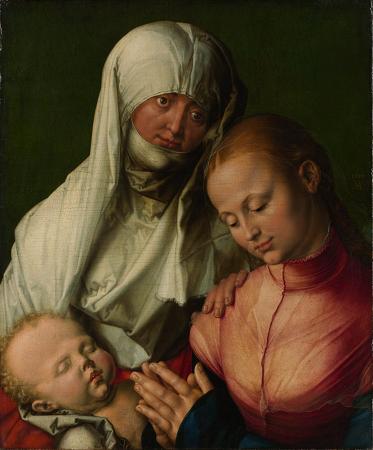Saint Anne. According to apocryphal Christian and Islamic tradition, Saint Anne was the mother of Mary and grandmother of Jesus. Mary's mother is not named in the canonical gospels. In writing, Anne's name and that of her husband Joachim come only from New Testament apocrypha, of which the Gospel of James seems to be the earliest that mentions them.The mother of Mary is mentioned, but not named, in the Quran. The story bears a similarity to that of the birth of Samuel, whose mother Hannah had also been childless. Although Anne receives little attention in the Latin Church prior to the late 12th century,dedications to Anne in Eastern Christianity occur as early as the 6th century. In the Eastern Orthodox tradition, Hannah is ascribed the title Forebear of God, and both the Nativity of Mary and the Presentation of Mary are celebrated as two of the twelve Great Feasts of the Orthodox Church. The Dormition of Hannah is also a minor feast in Eastern Christianity. In Lutheran Protestantism, it is held that Martin Luther chose to enter religious life as an Augustinian friar after crying out to St. Anne while endangered by lightning. Anne is also revered in Islam, recognized as a highly spiritual woman and as the mother of Mary. She is not named in the Quran, where she is referred to as The wife of 'Imran. The Qur'an describes her remaining childless until her old age. One day, Hannah saw a bird feeding its young while sitting in the shade of a tree, which awakened her desire to have children of her own. She prayed for a child and eventually conceived; her husband, Imran, died before the child was born. Expecting the child to be male, Hannah vowed to dedicate him to isolation and service in the Second Temple. However, Hannah bore a daughter instead, and named her Mary. Her words upon delivering Mary reflect her status as a great mystic, realising that while she had wanted a son, this daughter was God's gift to her: Then, when she brought forth she said: My Lord! Truly, I brought her forth, a female. And God is greater in knowledge of what she brought forth. And the male is not like the female. So her Lord received her with the very best acceptance. And her bringing forth caused the very best to develop in her. Although the canonical books of the New Testament never mention the mother of the Virgin Mary, traditions about her family, childhood, education, and eventual betrothal to Joseph developed very early in the history of the church. The oldest and most influential source for these is the apocryphal Gospel of James, first written in Koine Greek around the middle of the second century AD. In the West, the Gospel of James fell under a cloud in the fourth and fifth centuries when it was accused of absurdities by Jerome and condemned as untrustworthy by Pope Damasus I, Pope Innocent I, and Pope Gelasius I. Ancient belief, attested to by a sermon of John of Damascus, was that Anne married once. In the Late Middle Ages, legend held that Anne was married three times: first to Joachim, then to Clopas and finally to a man named Solomas and that each marriage produced one daughter: Mary, mother of Jesus, Mary of Clopas, and Mary Salome, respectively. The sister of Saint Anne was Sobe, mother of Elizabeth. In the fifteenth century, the Catholic cleric Johann Eck related in a sermon that St Anne's parents were named Stollanus and Emerentia. The Catholic Encyclopedia regards this genealogy as spurious. In the 4th century and then much later in the 15th century, a belief arose that Mary was born of Anne by virgin birth, the Immaculate Conception, preserving Mary's body and soul intact and sinless from the first moment of existence. The Immaculate Conception, often confused with the Annunciation of the Incarnation, was made doctrine in the Catholic church by a Pope Pius IX papal bull, Ineffabilis Deus, in 1854. In the Eastern church, the cult of Anne herself may go back as far as c. 550, when Justinian built a church in Constantinople in her honor. The earliest pictorial sign of her veneration in the West is an 8th-century fresco in the church of Santa Maria Antiqua, Rome. Virginia Nixon sees an economic incentive in the local promotion of the cult of St. Anne in order to attract pilgrims. The identification of Sepphoris as the birthplace of Mary may reflect competition with a similar site in Jerusalem.A shrine at Douai, in northern France, was one of the early centers of devotion to St. Anne in the West.
more...













